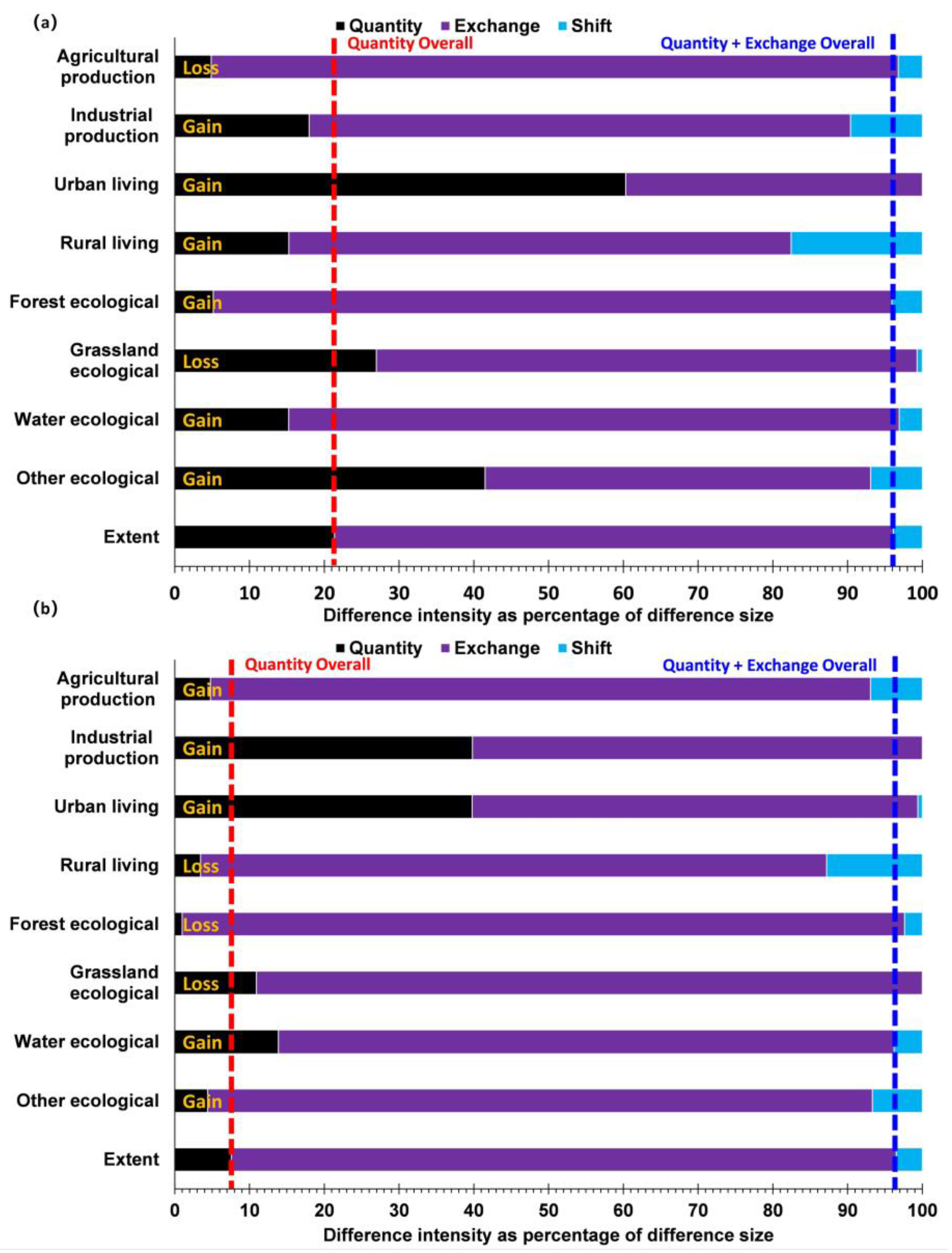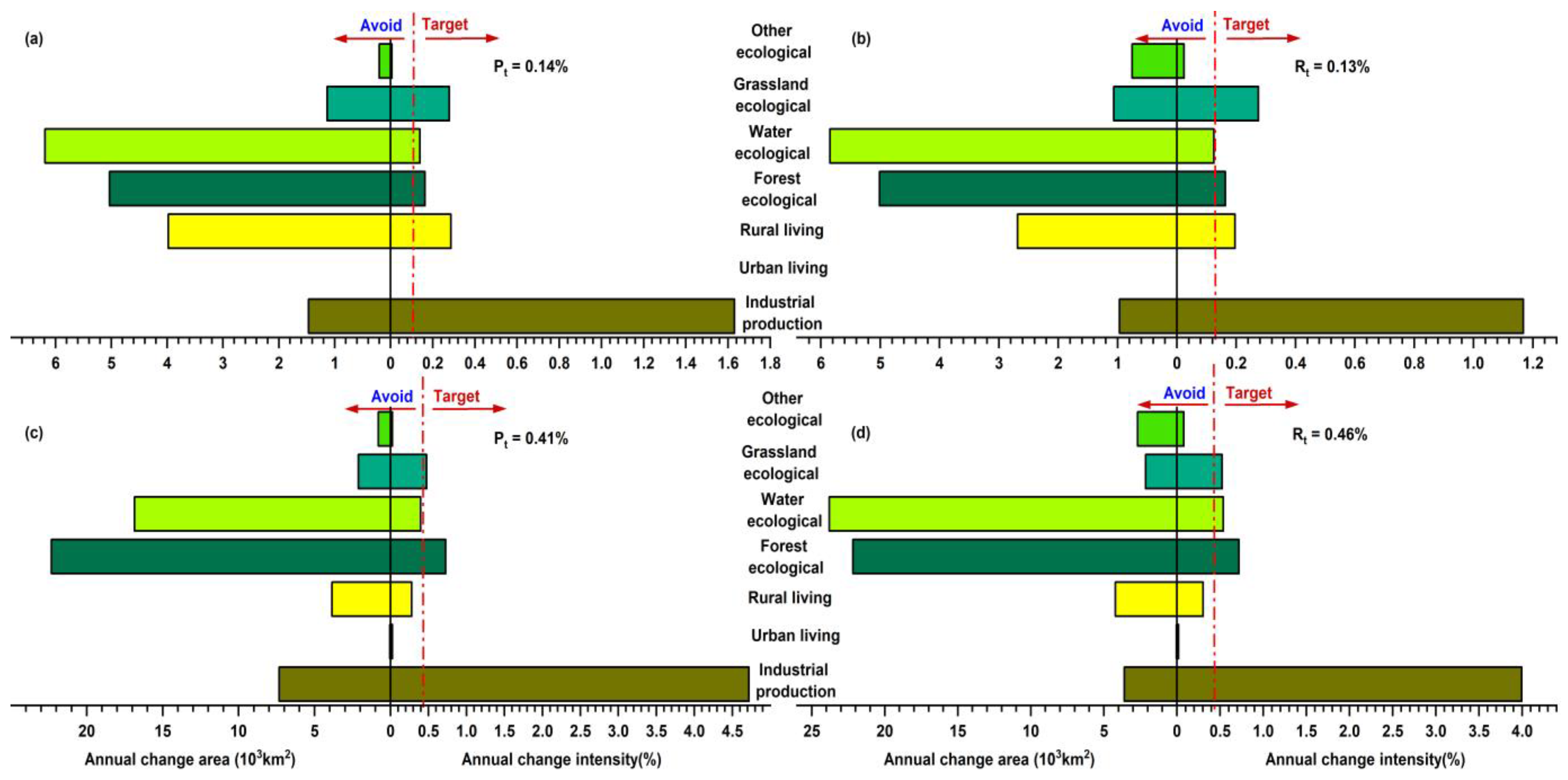A Study on the Spatial Change of Production–Living–Ecology in China in the Past Two Decades Based on Intensity Analysis in the Context of Arable Land Protection and Sustainable Development
Abstract
:1. Introduction
2. Materials and Methods
2.1. Study Area
2.2. Data Source and Processing
2.3. Methods
2.3.1. Change Component Analysis
2.3.2. Intensity Analysis
3. Results
3.1. PLES Distribution Characteristics
3.2. Analysis of the Components of the PLES
3.2.1. Analysis of Total PLES Component Change
3.2.2. Analysis of the Change Components of Different Categories
3.3. Intensity Analysis of the PLES
3.3.1. Change Detection at Time Interval Level
3.3.2. Change Detection at a Category Level
3.3.3. Agricultural Production Space Change Detection at a Transition Level
4. Discussion
4.1. Patterns and Processes of PLES Change
4.2. Effectiveness of Cropland Protection Policies
4.3. Uncertainty and Future Research Direction
5. Conclusions
Author Contributions
Funding
Institutional Review Board Statement
Informed Consent Statement
Data Availability Statement
Conflicts of Interest
References
- Hao, Q.; Peng, J.; Wei, Y.; Wang, F.-L.; Yao, H.-S.; Li, Y.; Wang, W.; Zhang, S.-H.; Deng, L.; Zhao, Y.-T.; et al. The connotation of territory and the suggestions of drawing up spatial planning in the New Era. J. Nat. Resour. 2021, 36, 2219–2247. [Google Scholar] [CrossRef]
- Duan, Y.; Huang, A.; Lu, H.; Ji, Z.; Xu, Y. Analysis on concept and theories of “Production-Living-Ecological” spaces. J. China Agric. Univ. 2023, 28, 170–182. [Google Scholar]
- Huang, A.; Xu, Y.; Lu, L.; Liu, C.; Zhang, Y.; Hao, J.; Wang, H. Research progress of the identification and optimization of production-living-ecological spaces. Prog. Geogr. 2020, 39, 503–518. [Google Scholar] [CrossRef]
- Fang, C.; Yang, J.; Fang, J.; Huang, X.; Zhou, Y. Optimization Transmission Theory and Technical Pathways that Describe Multiscale Urban Agglomeration Spaces. Chin. Geogr. Sci. 2018, 28, 543–554. [Google Scholar] [CrossRef]
- Bren d’Amour, C.; Reitsma, F.; Baiocchi, G.; Barthel, S.; Güneralp, B.; Erb, K.-H.; Haberl, H.; Creutzig, F.; Seto, K.C. Future urban land expansion and implications for global croplands. Proc. Natl. Acad. Sci. USA 2017, 114, 8939–8944. [Google Scholar] [CrossRef]
- Jiang, P.; Li, M.; Cheng, L. Dynamic response of agricultural productivity to landscape structure changes and its policy implications of Chinese farmland conservation. Resour. Conserv. Recycl. 2020, 156, 104724. [Google Scholar] [CrossRef]
- Chen, M.X.; Liang, L.W.; Wang, Z.B.; Zhang, W.Z.; Yu, J.H.; Liang, Y. Geographical thoughts on the relationship between ‘Beautiful China’ and land spatial planning. J. Geogr. Sci. 2020, 30, 705–723. [Google Scholar] [CrossRef]
- Tobias, S.; Price, B. How Effective Is Spatial Planning for Cropland Protection? An Assessment Based on Land-Use Scenarios. Land 2020, 9, 20. [Google Scholar] [CrossRef]
- Gao, J.; O’Neill, B.C. Mapping global urban land for the 21st century with data-driven simulations and Shared Socioeconomic Pathways. Nat. Commun. 2020, 11, 2302. [Google Scholar] [CrossRef]
- Deng, Z.; Quan, B. Intensity Analysis to Communicate Detailed Detection of Land Use and Land Cover Change in Chang-Zhu-Tan Metropolitan Region, China. Forests 2023, 14, 939. [Google Scholar] [CrossRef]
- Bu, Z.; Fu, J.; Jiang, D.; Lin, G. Production–Living–Ecological Spatial Function Identification and Pattern Analysis Based on Multi-Source Geographic Data and Machine Learning. Land 2023, 12, 2029. [Google Scholar] [CrossRef]
- Lin, G.; Fu, J.; Jiang, D. Production–Living–Ecological Conflict Identification Using a Multiscale Integration Model Based on Spatial Suitability Analysis and Sustainable Development Evaluation: A Case Study of Ningbo, China. Land 2021, 10, 383. [Google Scholar] [CrossRef]
- Peng, Y.; Luan, Q.; Xiong, C. Evaluation of Spatial Functions and Scale Effects of “Production–Living–Ecological” Space in Hainan Island. Land 2023, 12, 1637. [Google Scholar] [CrossRef]
- Huang, J.; Lin, H.; Qi, X. A literature review on optimization of spatial development pattern based on ecological-production-living space. Prog. Geogr. 2017, 36, 378–391. [Google Scholar]
- Liu, J.; Liu, Y.; Li, Y. Classification evaluation and spatia-temporal analysis of “production–living–ecological” spaces in China. Acta Geogr. Sin. 2017, 72, 1290–1304. [Google Scholar]
- Zhang, H.; Xu, E.; Zhu, H. An ecological-living-industrial land classification system and its spatial distribution in China. Resour. Sci. 2015, 37, 1332–1338. [Google Scholar]
- Li, J.Y.; Zheng, X.Q.; Zhang, C.X.; Chen, Y.M. Impact of Land-Use and Land-Cover Change on Meteorology in the Beijing-Tianjin-Hebei Region from 1990 to 2010. Sustainability 2018, 10, 22. [Google Scholar] [CrossRef]
- Liu, B.; Pan, L.B.; Qi, Y.; Guan, X.; Li, J.S. Land Use and Land Cover Change in the Yellow River Basin from 1980 to 2015 and Its Impact on the Ecosystem Services. Land 2021, 10, 23. [Google Scholar] [CrossRef]
- Yang, H.F.; Zhong, X.N.; Deng, S.Q.; Nie, S.N. Impact of LUCC on landscape pattern in the Yangtze River Basin during 2001–2019. Ecol. Inform. 2022, 69, 14. [Google Scholar] [CrossRef]
- Wei, T.; Shangguan, D.; Shen, X.; Ding, Y.; Yi, S. Dynamics of Land Use and Land Cover Changes in An Arid Piedmont Plain in the Middle Reaches of the Kaxgar River Basin, Xinjiang, China. ISPRS Int. J. Geo-Inf. 2020, 9, 87. [Google Scholar] [CrossRef]
- Yu, M.Y.; Meng, F.; Cui, J. Spatial Analysis of Land Use and Land Cover Changes on the Basis of RS and GIS. In Proceedings of the International Conference on Civil Engineering and Transportation (ICCET 2011), Jinan, China, 14–16 October 2011; pp. 1711–1714. [Google Scholar]
- Aldwaik, S.Z.; Pontius, R.G. Intensity analysis to unify measurements of size and stationarity of land changes by interval, category, and transition. Landsc. Urban Plan. 2012, 106, 103–114. [Google Scholar] [CrossRef]
- Pontius, R.G.; Millones, M. Death to Kappa: Birth of Quantity Disagreement and Allocation Disagreement for Accuracy Assessment; Taylor & Francis: Abingdon, UK, 2011; Volume 32, pp. 4407–4429. [Google Scholar]
- Deng, Z.; Quan, B. Intensity Characteristics and Multi-Scenario Projection of Land Use and Land Cover Change in Hengyang, China. Int. J. Environ. Res. Public Health 2022, 19, 8491. [Google Scholar] [CrossRef]
- Huang, B.; Huang, J.; Pontius, R.G., Jr.; Tu, Z. Comparison of Intensity Analysis and the land use dynamic degrees to measure land changes outside versus inside the coastal zone of Longhai, China. Ecol. Indic. 2018, 89, 336–347. [Google Scholar] [CrossRef]
- Fan, X.; Quan, B.; Deng, Z.; Liu, J. Study on Land Use Changes in Changsha–Zhuzhou–Xiangtan under the Background of Cultivated Land Protection Policy. Sustainability 2022, 14, 15162. [Google Scholar] [CrossRef]
- Quan, B.; Pontius, R.G.; Song, H. Intensity Analysis to communicate land change during three time intervals in two regions of Quanzhou City, China. GISci. Remote Sens. 2020, 57, 21–36. [Google Scholar] [CrossRef]
- Shafizadeh-Moghadam, H.; Minaei, M.; Feng, Y.; Pontius, R.G. GlobeLand30 maps show four times larger gross than net land change from 2000 to 2010 in Asia. Int. J. Appl. Earth Obs. Geoinf. 2019, 78, 240–248. [Google Scholar] [CrossRef]
- Varga, O.G.; Pontius, R.G., Jr.; Szabó, Z.; Szabó, S. Effects of Category Aggregation on Land Change Simulation Based on Corine Land Cover Data. Remote Sens. 2020, 12, 1314. [Google Scholar] [CrossRef]
- Zhou, Z.; Quan, B.; Deng, Z. Effects of Land Use Changes on Ecosystem Service Value in Xiangjiang River Basin, China. Sustainability 2023, 15, 2492. [Google Scholar] [CrossRef]
- Yuan, N.; Feng, Y.Q.; Liang, S.H.; Wang, G.J.; Yin, T.; Yan, D.Z.; Wu, P.; Kuang, X.X.; Wan, L. Spatial gathering characteristics of drought in the Qinghai-Tibet Plateau. Front. Environ. Sci. 2022, 10, 12. [Google Scholar] [CrossRef]
- Chatterjee, S.; Dinda, A. Determination of Characterized Urban Thermal Zones (UTZ) for Assessing Microclimates in the Tropical Metropolitan Area of Kolkata. Sust. Cities Soc. 2022, 80, 17. [Google Scholar] [CrossRef]
- Mushore, T.D.; Mutanga, O.; Odindi, J. Determining the Influence of Long Term Urban Growth on Surface Urban Heat Islands Using Local Climate Zones and Intensity Analysis Techniques. Remote Sens. 2022, 14, 22. [Google Scholar] [CrossRef]
- Kuang, W.; Zhang, S.; Du, G.; Yan, C.; Wu, S.; Li, R.; Lu, D.; Pan, T.; Ning, J.; Guo, C.; et al. Monitoring periodically national land use changes and analyzing their spatiotemporal patterns in China during 2015–2020. J. Geogr. Sci. 2022, 32, 1705–1723. [Google Scholar] [CrossRef]
- Xi, J. Holding high the great banner of socialism with Chinese characteristics and unitedly striving for the comprehensive construction of a modernized socialist country. People’s Daily, 26 October 2022; p. 001. [Google Scholar]
- Wang, J.Y.; He, D.Q. Sustainable urban development in China: Challenges and achievements. Mitig. Adapt. Strateg. Glob. Chang. 2015, 20, 665–682. [Google Scholar] [CrossRef]
- Hu, J. Advancing Firmly Along the Road of Socialism with Chinese Characteristics Striving to Build a Moderately Prosperous Society in All Aspects. People’s Daily, 18 November 2012; p. 001. [Google Scholar]
- Fu, J.; Gao, Q.; Jiang, D.; Li, X.; Lin, G. Spatial–temporal distribution of global production–living–ecological space during the period 2000–2020. Sci. Data 2023, 10, 589. [Google Scholar] [CrossRef] [PubMed]
- Pontius, R.G.; Santacruz, A. Quantity, exchange, and shift components of difference in a square contingency table. Int. J. Remote Sens. 2014, 35, 7543–7554. [Google Scholar] [CrossRef]
- Li, L.; Zheng, S.; Zhao, K.; Shen, K.; Yan, X.; Zhao, Y. The Quantitative Impact of the Arable Land Protection Policy on the Landscape of Farmland Abandonment in Guangdong Province. Remote Sens. 2022, 14, 4991. [Google Scholar] [CrossRef]
- Zhou, Y.; Li, X.; Liu, Y. Cultivated land protection and rational use in China. Land Use Pol. 2021, 106, 105454. [Google Scholar] [CrossRef]
- Lai, L.; Huang, X.J.; Yang, H.; Chuai, X.W.; Zhang, M.; Zhong, T.Y.; Chen, Z.G.; Chen, Y.; Wang, X.; Thompson, J.R. Carbon emissions from land-use change and management in China between 1990 and 2010. Sci. Adv. 2016, 2, 8. [Google Scholar] [CrossRef]
- Ning, J.; Liu, J.; Kuang, W.; Xu, X.; Zhang, S.; Yan, C.; Li, R.; Wu, S.; Hu, Y.; Du, G.; et al. Spatiotemporal patterns and characteristics of land-use change in China during 2010–2015. J. Geogr. Sci. 2018, 28, 547–562. [Google Scholar] [CrossRef]







| Primary Category | Secondary Category | Content |
|---|---|---|
| The production space | 1. Agricultural production space | GlobeLand30: cropland |
| 2. Industrial production space | GlobeLand30: artificial surface | |
| The living space | 3. Urban living space | Population density is greater than 1500/km2 |
| 4. Rural living space | Population density is 300–1500/km2 | |
| The ecological space | 5. Forest ecological space | GlobeLand30: forest, bush |
| 6. Grassland ecological space | GlobeLand30: grass | |
| 7. Water ecological space | GlobeLand30: wetlands, water, glaciers, and permanent snow cover | |
| 8. Other ecological spaces | GlobeLand30: tundra, bare land |
Disclaimer/Publisher’s Note: The statements, opinions and data contained in all publications are solely those of the individual author(s) and contributor(s) and not of MDPI and/or the editor(s). MDPI and/or the editor(s) disclaim responsibility for any injury to people or property resulting from any ideas, methods, instructions or products referred to in the content. |
© 2023 by the authors. Licensee MDPI, Basel, Switzerland. This article is an open access article distributed under the terms and conditions of the Creative Commons Attribution (CC BY) license (https://creativecommons.org/licenses/by/4.0/).
Share and Cite
Cui, G.; Dong, D.; Gao, Q. A Study on the Spatial Change of Production–Living–Ecology in China in the Past Two Decades Based on Intensity Analysis in the Context of Arable Land Protection and Sustainable Development. Sustainability 2023, 15, 16837. https://doi.org/10.3390/su152416837
Cui G, Dong D, Gao Q. A Study on the Spatial Change of Production–Living–Ecology in China in the Past Two Decades Based on Intensity Analysis in the Context of Arable Land Protection and Sustainable Development. Sustainability. 2023; 15(24):16837. https://doi.org/10.3390/su152416837
Chicago/Turabian StyleCui, Guangyuan, Donglin Dong, and Qiang Gao. 2023. "A Study on the Spatial Change of Production–Living–Ecology in China in the Past Two Decades Based on Intensity Analysis in the Context of Arable Land Protection and Sustainable Development" Sustainability 15, no. 24: 16837. https://doi.org/10.3390/su152416837




